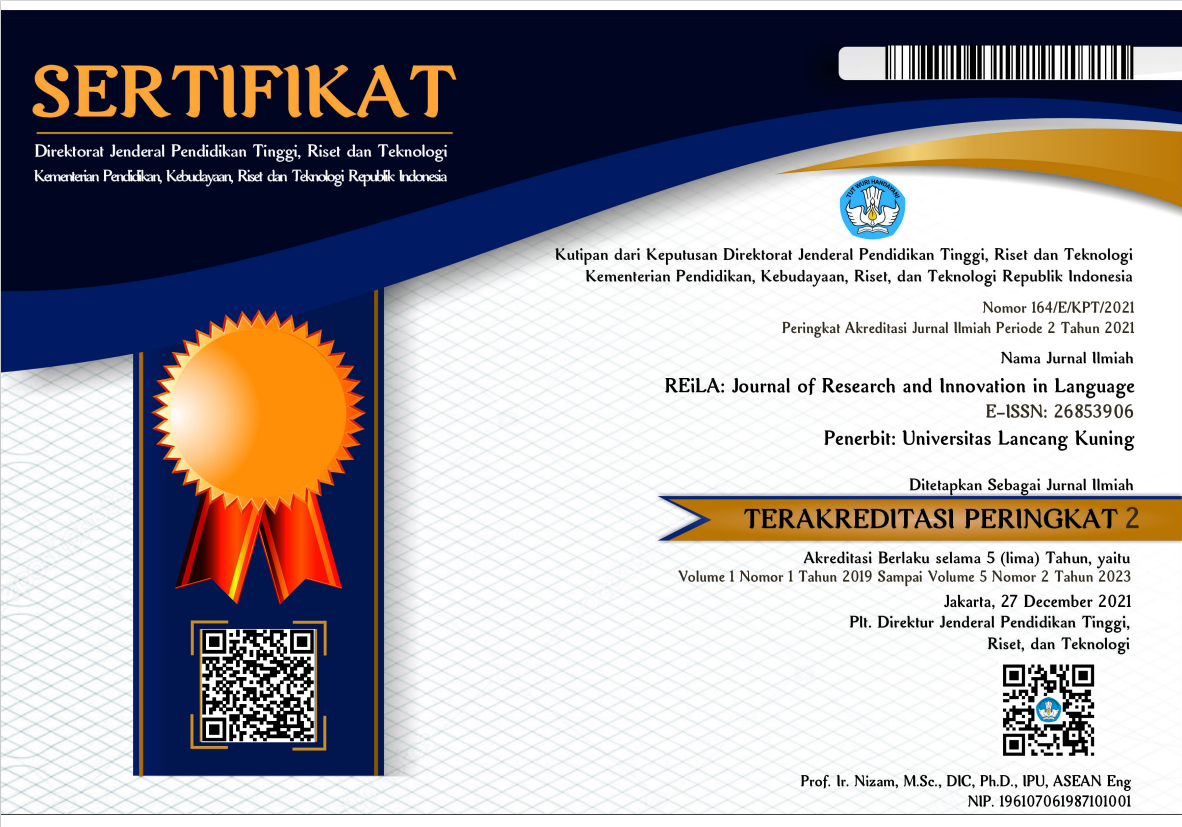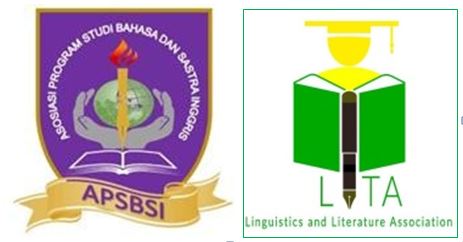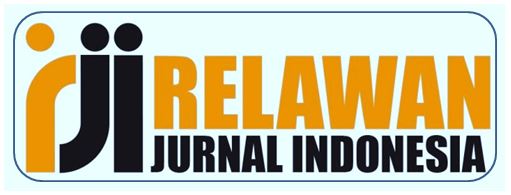A Morphological Process of Derivational Affixes in Popular LINE Webtoon: The Annarasumanara
Abstract
This research tries to analyze the morphological process of derivational affixes in a popular LINE Webtoon comic titled Annarasumanara authored by Il Kwon Ha. This research uses a synchronic descriptive approach in which data are collected and explained naturally. The objects of this research are the conversations in Annarasumanara from episode 1 to 10. The results of the research are 53 words that changed word classes, involving 7 derivational prefixes and 47 derivational suffixes. The suffix “-ly” is the most dominantly used in the Webtoon. This study revealed not only the detailed morphological process of affix analysis but also the grammatical categories of words and meanings.
Downloads
References
Abrar, M. (2014). Derivation of Indonesian Language in Three Indonesian Texts. LearnING Journal, 1(1), 59–85.
Alhasibunur. (2016). The Anaysis of Morphological Process of Students’ English Utterances. Journal of Languages and Language Teaching, 4(2), 47–54. https://doi.org/https://doi.org/10.33394/jollt.v4i2.316
Ansar, F. A. (2016). Affix In Sentence Pattern of Indonesia-Makassarese Dialect. English Education: Jurnal Tadris Bahasa Inggris IAIN Raden Intan, 9(2), 308–326. https://doi.org/10.24042/ee-jtbi.v9i2.378
Bunau, E., & Yusof, R. M. (2018). Morpheme {Bun-}: An Example of Morphological Process Through Affixation in Bidayuh-Somu Language. Lingua Cultura, 12(2), 203–208. https://doi.org/10.21512/lc.v12i2.3962
Ciaccio, L. A., & Jacob, G. (2019). Native speakers like affixes, L2 speakers like letters? An overt visual priming study investigating the role of orthography in L2 morphological processing. PLoS ONE, 14(12). https://doi.org/10.1371/journal.pone.0226482
DeKeyser, R. M. (2005). What makes learning second-language grammar difficult? A review of issues. Language Learning, 55(SUPPL. 1), 1–25. https://doi.org/10.1111/j.0023-8333.2005.00294.x
Derin, T., Deliani, S., Fauziah, N., Afifah, N., & Hamuddin, B. (2019). Indonesians’ Tendency to Refer Abbreviation as Acronym: Types of Abbreviation as Word Formation Process. Globish: An English-Indonesian Journal for English, Education, and Culture. https://doi.org/10.31000/globish.v8i2.1654
Dixon, R. M. ., & Aikhenvald, A. Y. (2012). Adjective Classes; A Cross-Linguistic Typology. Oxford University Press.
Djajasudarma, T. F. (2013). Metode Linguistik: Ancangan Metode Penelitian dan Kajian. PT. Eresco.
Efransyah, E. (2019). Teaching Derivational Process to Compose Proper Sentence. ELTIN JOURNAL, Journal of English Language Teaching in Indonesia, 7(1), 23. https://doi.org/10.22460/eltin.v7i1.p23-34
Ekerete Josiah, U., & Charles Udoudom, J. (2012). Morphophonemic Analysis of Inflectional Morphemes in English and Ibibio Nouns: Implications for Linguistic Studies. Journal of Education and Learning, 1(2). https://doi.org/10.5539/jel.v1n2p72
Embick, D. (2015). The Morpheme - A Theoretical Introduction. Walter de Gruyter mouton.
Hamuddin, B., Syahdan, S., Rahman, F., Rianita, D., & Derin, T. (2019). Do They Truly Intend to Harm their Friends? The Motives Beyond Cyberbullying Among University Students. International Journal of Cyber Behavior, Psychology and Learning, 9(4), 32–44. https://doi.org/10.4018/IJCBPL.2019100103
Herlambang, A. A. (2020). 10 Aplikasi Baca Komik Gratis Paling Populer.
Istiqomah, L., Khasanah, D., Tauhida, A., Ningtyas, R. A., & Nur, A. (2020). Indonesian to English Translation Strategies Used in Webtoon “ My Pre-Wedding .” ELSYA : Journal of English Language Studies, 2(2), 1–6. https://doi.org/10.31849/elsya.v2i2.4024
Khan, S., Akram, W., & Khan, A. (2016). Functions of Inflectional Morphemes in English and Pashto Language. Journal of Applied Linguistics and Language Research, 3(1), 197–216.
Kimppa, L., Shtyrov, Y., Hut, S. C. A., Hedlund, L., Leminen, M., & Leminen, A. (2019). Acquisition of L2 morphology by adult language learners. Cortex, 116, 74–90. https://doi.org/10.1016/j.cortex.2019.01.012
Musa, R. I., Rahman, A., & Altakhaineh, M. (2015). An Application of Optimality Theory (OT) on Syllable Structure within Reduplication in Hausa Spoken in Kano. In International Journal of English Language and Linguistics Research (Vol. 3, Issue 1).
Putri, A. S. (2018). Derivational Affixes on Song Lyrics in Justin Bieber’s Purpose Album. State Islamic University Sunan Ampel.
Rastle, K. (2019). The place of morphology in learning to read in English. In Cortex (Vol. 116, pp. 45–54). Masson SpA. https://doi.org/10.1016/j.cortex.2018.02.008
Rustamaji, E. (2015). Process of English Word Formation Found in Advertisement Boards in Kendal Regency Faculty of Languages and Arts.
Sibona, C., & Walczak, S. (2012). Purposive sampling on Twitter: A case study. Proceedings of the Annual Hawaii International Conference on System Sciences, 3510–3519. https://doi.org/10.1109/HICSS.2012.493
Unubi, A. S., & Yusuf, S. (2017). Selected Derivational Morphological Processes in English, Hausa, Igala and Some other Languages of the World Some of the authors of this publication are also working on these related projects: essential linguistic knowledge on french and english languages. Wo Rld Wid e Jou Rnal of M Ulti Disc Iplin Ary R Esea Rch and Dev Elop Men T, 3(12), 425–439.
Utami, S. (2014). Errors on Words Formation Made by the Second Semester Students of English Department of Kutai Kartanegara University. Jurnal Cemerlang, 2(1).
Yablonski, M., Rastle, K., Taylor, J. S. H., & Ben-Shachar, M. (2019). Structural properties of the ventral reading pathways are associated with morphological processing in adult English readers. Cortex, 116, 268–285. https://doi.org/10.1016/j.cortex.2018.06.011
Yunira, S., Fradina, S., Sumbayak, M., Putri, N. S., & Derin, T. (2020). Re-Visits the Grand Theory of Geoffrey Leech: Seven Types of Meaning. REiLA : Journal of Research and Innovation in Language, 1(3), 105–110. https://doi.org/10.31849/reila.v1i3.3768










